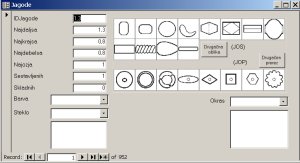 Institute of Archaeology Institute of Archaeology |
[Slovenian] |
| Home | Members | Programme | Projects | Laboratory |
| Database | Publications | Library | Links | Archive |
|
Computer-aided archaeological database of the Early Medieval artefacts 
The smaller european states have to retain their identity in the large European Union. The cultural plurality of the united Europe could be one of the decisive opportunities for our common future. The archaeology of the earlymediaeval ages brings fundamental evidences about the life of our ancestors in the time, when the contemporary Europe was born. For the explanation of this historical processes are important the structures of the ancient societies, which could be identified on the excavated graveyards and settlements in the wide area of the Central Europe and their comparison. But such research is not possible without good informatical management of the archaeological heritage. Archeology must manage the huge amounts of artifacts and therefore the data. Today is this not possible without the computer-aided informatics. The object of our project is the development of the scientific computer-aided database for archaeological artefacts from the early medieval ages in Central Europe. The digital data make possible easy data-exchange among specialists and so support international science co-operation with its synergetic effects. The greatest problem in this kind of database we see in two topics: at first the database must be enough common structured for archaeological material from different regions, which is partly various. At second: the database must contain maximum of information about archaeological artefacts, which are necessary for complex over-regional statistical and other analysis. If we want to find the best solution, we should discuss the concept of the database in international and interregional context. In the frame of our project we should like to combine and sinhronize our experiences and find the best way how to develop the archaeological database for earlymedieval artefacts. We plan to develope for the slovac side an application for input the data and to improve the existing slovenian application. The both applications should be compatible so far, that the comparible analyses could be made. The next step could be the internet- access of our databases as a part of the science without the borders. Selected bibliography
Project coordinator Researchers
|
